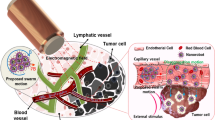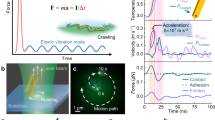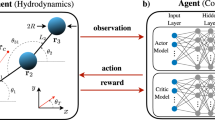Abstract
Navigating a large swarm of micro-/nanorobots is critical for potential targeted delivery/therapy applications owing to the limited volume/function of a single microrobot, and microrobot swarms with distribution reconfigurability can adapt to environments during navigation. However, current microrobot swarms lack the intelligent behaviour to autonomously adjust their distribution and motion according to environmental change. Such autonomous navigation is challenging, and requires real-time appropriate decision-making capability of the swarm for unknown and unstructured environments. Here, to tackle this issue, we propose a framework that defines different autonomy levels for environment-adaptive microrobot swarm navigation and designs corresponding system components for each level. To realize high autonomy levels, real-time autonomous distribution planning is a key capability for the swarm, regarding which we show that deep learning is an enabling approach that allows the microrobot swarm to learn optimal distributions in extensive unstructured environmental morphologies. For real-world demonstration, we study the reconfigurable magnetic nanoparticle swarm and experimentally demonstrate autonomous swarm navigation for targeted delivery and cargo transport in environments with channels or obstacles. This work could introduce computational intelligence to micro-/nanorobot swarms, enabling them to autonomously make appropriate decisions during navigation in unstructured environments.
This is a preview of subscription content, access via your institution
Access options
Access Nature and 54 other Nature Portfolio journals
Get Nature+, our best-value online-access subscription
$29.99 / 30 days
cancel any time
Subscribe to this journal
Receive 12 digital issues and online access to articles
$119.00 per year
only $9.92 per issue
Buy this article
- Purchase on Springer Link
- Instant access to full article PDF
Prices may be subject to local taxes which are calculated during checkout






Similar content being viewed by others
Data availability
The dataset49 (~20 GB) used for training the DNNs is available in figshare (https://doi.org/10.6084/m9.figshare.19149779.v1).
Code availability
All the control and planning algorithms used in this study are available within the Article. Original codes for training the DNNs, sample codes for executing the swarm distribution planning in different environmental morphologies and sample codes50 for executing the trajectory planning in a channel environment are available on GitHub (https://github.com/lidongYang22/Autonomous-microrobot-swarm-navigation) and Zenodo (https://doi.org/10.5281/zenodo.6032452). The integrated software used for experimental validation is available from the corresponding author on reasonable request.
References
Floreano, D. & Lipson, H. From individual robots to robot societies. Sci. Robot. 6, eabk2787 (2021).
Rubenstein, M., Cornejo, A. & Nagpal, R. Programmable self-assembly in a thousand-robot swarm. Science 345, 795–799 (2014).
Soria, E., Schiano, F. & Floreano, D. Predictive control of aerial swarms in cluttered environments. Nat. Mach. Intell. 3, 545–554 (2021).
Li, S. et al. Particle robotics based on statistical mechanics of loosely coupled components. Nature 567, 361–365 (2019).
Shahrokhi, S., Lin, L., Ertel, C., Wan, M. & Becker, A. T. Steering a swarm of particles using global inputs and swarm statistics. IEEE Trans. Robot. 34, 207–219 (2017).
Ozkan-Aydin, Y. & Goldman, D. I. Self-reconfigurable multilegged robot swarms collectively accomplish challenging terradynamic tasks. Sci. Robot. 6, eabf1628 (2021).
Dorigo, M., Theraulaz, G. & Trianni, V. Reflections on the future of swarm robotics. Sci. Robot. 5, eabe4385 (2020).
Ahmed, D. et al. Bioinspired acousto-magnetic microswarm robots with upstream motility. Nat. Mach. Intell. 3, 116–124 (2021).
Wu, C. et al. Ion-exchange enabled synthetic swarm. Nat. Nanotechnol. 16, 288–295 (2021).
Dong, X. & Sitti, M. Controlling two-dimensional collective formation and cooperative behavior of magnetic microrobot swarms. Int. J. Robot. Res. 39, 617–638 (2020).
Yang, L. et al. A survey on swarm microrobotics. IEEE Trans. Robot. https://doi.org/10.1109/TRO.2021.3111788 (2021).
Felfoul, O. et al. Magneto-aerotactic bacteria deliver drug-containing nanoliposomes to tumour hypoxic regions. Nat. Nanotechnol. 11, 941–947 (2016).
Wu, Z. et al. A swarm of slippery micropropellers penetrates the vitreous body of the eye. Sci. Adv. 4, eaat4388 (2018).
Martel, S. & Mohammadi, M. Using a swarm of self-propelled natural microrobots in the form of flagellated bacteria to perform complex micro-assembly tasks. In 2010 IEEE International Conference on Robotics and Automation 500–505 (IEEE, 2010).
Dekanovsky, L. et al. Chemically programmable microrobots weaving a web from hormones. Nat. Mach. Intell. 2, 711–718 (2020).
Li, J., de Ávila, B. E.-F., Gao, W., Zhang, L. & Wang, J. Micro/nanorobots for biomedicine: delivery, surgery, sensing, and detoxification. Sci. Robot. 2, eaam6431 (2017).
Servant, A., Qiu, F., Mazza, M., Kostarelos, K. & Nelson, B. J. Controlled in vivo swimming of a swarm of bacteria-like microrobotic flagella. Adv. Mater. 27, 2981–2988 (2015).
Hortelao, A. C. et al. Swarming behavior and in vivo monitoring of enzymatic nanomotors within the bladder. Sci. Robot. 6, eabd2823 (2021).
Wang, Q. et al. Ultrasound Doppler-guided real-time navigation of a magnetic microswarm for active endovascular delivery. Sci. Adv. 7, eabe5914 (2021).
Miskin, M. Z. et al. Electronically integrated, mass-manufactured, microscopic robots. Nature 584, 557–561 (2020).
Cheng, R. et al. Acceleration of tissue plasminogen activator-mediated thrombolysis by magnetically powered nanomotors. ACS Nano 8, 7746–7754 (2014).
Hwang, G. et al. Catalytic antimicrobial robots for biofilm eradication. Sci. Robot. 4, eaaw2388 (2019).
Melde, K., Mark, A. G., Qiu, T. & Fischer, P. Holograms for acoustics. Nature 537, 518–522 (2016).
Zhou, Z., Hou, Z. & Pei, Y. Reconfigurable particle swarm robotics powered by acoustic vibration tweezer. Soft Robot. 8, 735–743 (2020).
Yu, J., Yang, L. & Zhang, L. Pattern generation and motion control of a vortex-like paramagnetic nanoparticle swarm. Int. J. Robot. Res. 37, 912–930 (2018).
Xie, H. et al. Reconfigurable magnetic microrobot swarm: multimode transformation, locomotion, and manipulation. Sci. Robot. 4, eaav8006 (2019).
Kaiser, A., Snezhko, A. & Aranson, I. S. Flocking ferromagnetic colloids. Sci. Adv. 3, e1601469 (2017).
Loghin, D., Tremblay, C., Mohammadi, M. & Martel, S. Exploiting the responses of magnetotactic bacteria robotic agents to enhance displacement control and swarm formation for drug delivery platforms. Int. J. Robot. Res. 36, 1195–1210 (2017).
Yu, J., Wang, B., Du, X., Wang, Q. & Zhang, L. Ultra-extensible ribbon-like magnetic microswarm. Nat. Commun. 9, 3260 (2018).
Kokot, G. & Snezhko, A. Manipulation of emergent vortices in swarms of magnetic rollers. Nat. Commun. 9, 2344 (2018).
Yigit, B., Alapan, Y. & Sitti, M. Programmable collective behavior in dynamically self-assembled mobile microrobotic swarms. Adv. Sci. 6, 1801837 (2019).
Liang, X. et al. Hierarchical microswarms with leader–follower-like structures: electrohydrodynamic self-organization and multimode collective photoresponses. Adv. Funct. Mater. 30, 1908602 (2020).
Hong, Y., Diaz, M., Córdova-Figueroa, U. M. & Sen, A. Light-driven titanium-dioxide-based reversible microfireworks and micromotor/micropump systems. Adv. Funct. Mater. 20, 1568–1576 (2010).
Yang, L., Yu, J. & Zhang, L. A mobile paramagnetic nanoparticle swarm with automatic shape deformation control. In 2020 IEEE International Conference on Robotics and Automation (ICRA) 9230–9236 (IEEE, 2020).
Sitti, M. Physical intelligence as a new paradigm. Extreme Mech. Lett. 46, 101340 (2021).
Cichos, F., Gustavsson, K., Mehlig, B. & Volpe, G. Machine learning for active matter. Nat. Mach. Intell. 2, 94–103 (2020).
Kaspar, C., Ravoo, B., van der Wiel, W., Wegner, S. & Pernice, W. The rise of intelligent matter. Nature 594, 345–355 (2021).
Mamdani, E. H. & Assilian, S. An experiment in linguistic synthesis with a fuzzy logic controller. Int. J. Man–Mach. Stud. 7, 1–13 (1975).
Yang, L., Yu, J. & Zhang, L. Statistics-based automated control for a swarm of paramagnetic nanoparticles in 2-D space. IEEE Trans. Robot. 36, 254–270 (2019).
Muiños-Landin, S., Fischer, A., Holubec, V. & Cichos, F. Reinforcement learning with artificial microswimmers. Sci. Robot. 6, eabd9285 (2021).
Karaman, S. & Frazzoli, E. Sampling-based algorithms for optimal motion planning. Int. J. Robot. Res. 30, 846–894 (2011).
Yu, J., Xu, T., Lu, Z., Vong, C. I. & Zhang, L. On-demand disassembly of paramagnetic nanoparticle chains for microrobotic cargo delivery. IEEE Trans. Robot. 33, 1213–1225 (2017).
Pérez-Higueras, N., Jardón, A., Rodríguez, Á. & Balaguer, C. 3D exploration and navigation with optimal-RRT planners for ground robots in indoor incidents. Sensors 20, 220 (2020).
Singh, A. Deep learning 3D structures. Nat. Methods 17, 249–249 (2020).
Karimi, D. et al. Accurate and robust deep learning-based segmentation of the prostate clinical target volume in ultrasound images. Med. Image Anal. 57, 186–196 (2019).
Chen, C. et al. Deep learning for cardiac image segmentation: a review. Front. Cardiovasc. Med. 7, 25 (2020).
Dou, Q., Coelho de Castro, D., Kamnitsas, K. & Glocker, B. Domain generalization via model-agnostic learning of semantic features. Adv. Neural Inf. Process. Syst. 32, 6450–6461 (2019).
Julien, D. 2D minimal bounding box. MATLAB Central File Exchange https://www.mathworks.com/matlabcentral/fileexchange/31126-2d-minimal-bounding-box (2011).
Yang, L. et al. Autonomous environment-adaptive microrobot swarm navigation enabled by deep learning-based real-time distribution planning (dataset). Figshare https://doi.org/10.6084/m9.figshare.19149779.v1 (2022).
Yang, L. et al. Autonomous environment-adaptive microrobot swarm navigation enabled by deep learning-based real-time distribution planning (sample codes). Zenodo https://doi.org/10.5281/zenodo.6032452 (2022).
Acknowledgements
We would like to thank S. Yang and D. Jin for help with the ultrasound experiments, T. Lam and K. Lai for help with the X-ray fluoroscopy experiments and K.-F. Chan for applying for permission for the navigation experiments in human placenta. We also would like to thank Prof. Ben M. Chen for the fruitful discussion.This project has received funding support from the Hong Kong Research Grants Council (E-CUHK401/20)(to L.Z.), the ITF project MRP/036/18X (to L.Z.), the Croucher Foundation grant CAS20403 (to L.Z.), CUHK internal grants (to L.Z.), the Multi-Scale Medical Robotics Center (MRC), InnoHK, at the Hong Kong Science Park (to L.Z.), the SIAT-CUHK Joint Laboratory of Robotics and Intelligent Systems (to L.Z.) and the CUHK Shun Hing Institute of Advanced Engineering (MMT-p5-20) (to Q.D.).
Author information
Authors and Affiliations
Contributions
L.Y. conceived the study. L.Y. and J.J. designed and implemented the system hardware and software, and performed the experiments. J.J., X.G. and Q.D. designed and coded the DL algorithms. Q.W. conducted the X-ray fluoroscopy experiment. L.Y. and J.J. wrote the manuscript with contributions from all authors. All authors contributed to the scientific discussion. L.Z. supervised the project.
Corresponding author
Ethics declarations
Competing interests
The authors declare no competing interests.
Peer review
Peer review information
Nature Machine Intelligence thanks Eric Diller and the other, anonymous, reviewer(s) for their contribution to the peer review of this work.
Additional information
Publisher’s note Springer Nature remains neutral with regard to jurisdictional claims in published maps and institutional affiliations.
Supplementary information
Supplementary Information
Supplementary Notes 1–10, Figs. 1–18, Table 1, Video legends 1–12 and refs. 1–3.
Supplementary Video 1
Robustness validation of the DNN-based swarm distribution planning method for different environmental morphologies, and comparison of computation time between this method and the traversal-based optimization method.
Supplementary Video 2
Experimental demonstration of the three swarm configurations and the transformations among them.
Supplementary Video 3
Experimental demonstration of the translational motion and rotational motion of the RS.
Supplementary Video 4
Experimental comparisons between manual navigation (autonomy level 0) and automated control (autonomy level 1).
Supplementary Video 5
Experimental demonstration of autonomy level 2, where two sets of experiments with different swarm sizes were conducted to assess the intelligence of the DNN-based swarm distribution planning method.
Supplementary Video 6
Experimental demonstration of autonomy level 3, where a swarm of magnetic nanorobots accomplished the delivery task to a targeted region in a channel environment.
Supplementary Video 7
Experimental demonstration of autonomy level 3, where the reconfigurable magnetic nanorobot swarm navigated in highly curved space with a 150° sharp turn and in a curved narrow channel environment.
Supplementary Video 8
Experimental demonstration of autonomy level 3, where the reconfigurable magnetic nanorobot swarm executed the cooperative micromanipulation task in confined space.
Supplementary Video 9
Experimental demonstration of the fully autonomous environment exploration using the magnetic nanorobot swarm in an unknown channel environment (autonomy level 4).
Supplementary Video 10
Experimental demonstration of the fully autonomous targeted delivery to a region with dynamic obstacles (autonomy level 4).
Supplementary Video 11
Transfer of the autonomy framework to the elliptical vortex-like magnetic nanoparticle swarm.
Supplementary Video 12
Method validation under ultrasound imaging and X-ray fluoroscopy.
Rights and permissions
About this article
Cite this article
Yang, L., Jiang, J., Gao, X. et al. Autonomous environment-adaptive microrobot swarm navigation enabled by deep learning-based real-time distribution planning. Nat Mach Intell 4, 480–493 (2022). https://doi.org/10.1038/s42256-022-00482-8
Received:
Accepted:
Published:
Issue Date:
DOI: https://doi.org/10.1038/s42256-022-00482-8
This article is cited by
-
Self-sustainable autonomous soft actuators
Communications Chemistry (2024)
-
Micro- and nanorobots for biofilm eradication
Nature Reviews Bioengineering (2024)
-
Autonomous 3D positional control of a magnetic microrobot using reinforcement learning
Nature Machine Intelligence (2024)
-
Smart micro- and nanorobots for water purification
Nature Reviews Bioengineering (2023)
-
Complex motion of steerable vesicular robots filled with active colloidal rods
Scientific Reports (2023)



